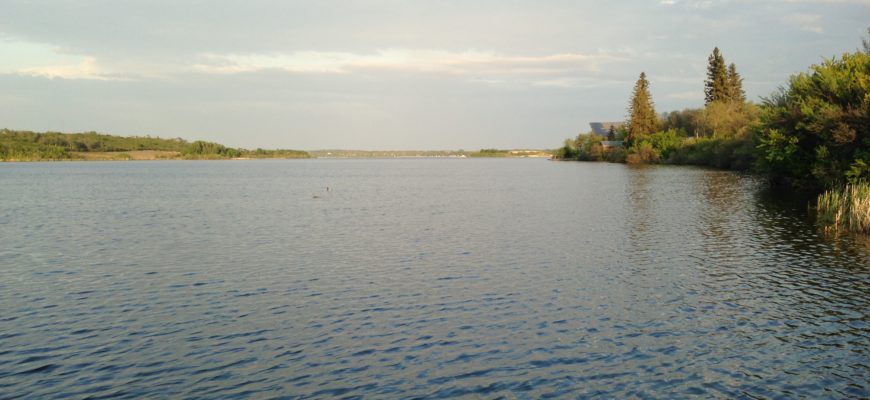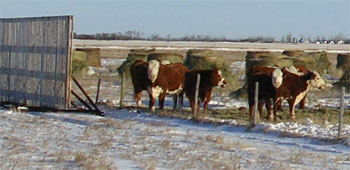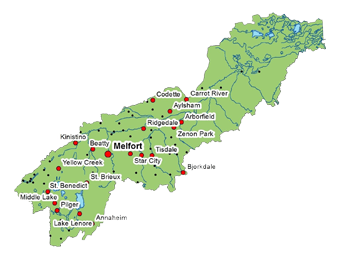Water Security Agency Forage Conversion Program
NAWMP_Target_Landscapes_SW_11x17
The Water Security Agency’s Forage Program Overview
The Water Security Agency’s (WSA) Forage Program is focused on a landowner’s conversion of annual cropland to perennial pasture. The landowner must sign an agreement with WSA to maintain the perennial pasture for a ten-year period. Seed costs are reimbursed up to $35 per acre.
It is important to note that invasive forage species are ineligible for WSA forage program. These species include: crested wheatgrass, smooth brome, timothy, kentucky blue grass, sweet clover, quack grass, and reed canary grass. Contact the Carrot River Valley Watershed Association (CRVWA) for details on eligible forage species or for application assistance.
Only land locations within the North American Waterfowl Management Plan landscapes are eligible: NAWMP_Target_Landscapes_SW_11x17. To check the eligibility of your land locations, contact the CRVWA (306-752-1270) or WSA (306-787-8577).
WSA Forage Program Environmental Benefits
Wetlands
The main goal of the WSA Forage Program is to help retain existing wetlands and provide upland nesting for waterfowl within the project area. Wetlands are very unique wildlife habitats with ample biodiversity and they are essential waterfowl nesting environments. Furthermore, wetlands provide beneficial services for people. Wetland plants are important in the natural filtration of water. Wetland plants are effective at utilizing excess nitrogen and phosphorus in the water so there is reduced water pollution downstream. Wetlands also help in flood protection and shoreline erosion control. They absorb water from rainstorms and snowmelt, and then release it slowly to provide streams and groundwater with a steady supply of fresh water. The spongy characteristic reduces the impacts of floods downstream and allows for a steady water supply for plants and animals (“Watersheds” Beck and Dobson, 1999).
Soil Health
Soil health is enhanced through conversion from annual crop production to perennial pastures. Soil and plants need each other to thrive. Soils are healthier when plants are continually covering them. As the health of the soil increases, so does the health of the plants growing from the soil. Soil health enhancement is vital to our province, as annual tilling, fertilizing, and harvesting continually degrade soil health. Specifically, perennial forages are directly responsible for a variety of improvements in the soil’s organic matter, structure, salinity, and fertility (Government of Manitoba, 2017).
Extensive root systems and reduced tillage help to build soil organic matter as microbes convert dead plant matter into plant nutrients. Soil organic matter is an essential piece to a healthy soil as it provides nutrients and habitat to the organisms in the soil. Soil organic matter also binds soil particles into aggregates that are responsible for an improvement of soil structure. A structured soil has a greater water holding capacity and is more resistant to crusting, compaction, droughts and erosion (Government of Manitoba, 2017).
Soil salinity can be managed through the use of forages as they provide cover to help reduce evaporation, thereby reducing the capillary rise of salts in the soil profile. Deep-rooted perennial forages can also lower the existing groundwater level, which allows salts to flush downward in the soil profile (Government of Alberta, 2007).
Certain forages increase soil fertility. Inoculated legume forages fix nitrogen from the air and make it available for plant growth and development. The nitrogen stored by the legume is then returned to the soil through root decay, thus increasing the fertility of the soil and reducing greenhouse gases. The increase of soil fertility using legumes reduces the need of artificial fertilizer and fertilizer runoff.
Contact Brady Myhr at (306) 752-1270 or (306) 920-7069 for more information.
Abandoned Water Well Decommissioning Demonstration

Unfortunately, it is very common for rural land owners to either neglect or improperly cover their unused water wells. These wells may expose groundwater to potentially irrecoverable contamination, pose a physical hazard to people, livestock and farm machinery, and may contribute to a legal liability and a reduction in property value. We are now pleased to present this video of a live demonstration we hosted last month which outlines the basic process for decommissioning large diameter bored wells. More detailed instructions and guidance may be found at www.wsask.ca.
Feral Wild Boar in Saskatchewan

Feral Wild Boar in Saskatchewan
Originally from Siberia, wild boar were first introduced to Saskatchewan as part of an agriculture diversification initiative. Escaping and released wild boar have become invasive throughout the province, and these highly adaptable, hardy, invasive species are prevalent throughout our watershed area. Feral wild boar have very few natural predators, are extremely intelligent, and are known to carry up to 30 different diseases that can harm humans and livestock including E.coli, bovine tuberculosis and foot and mouth disease. They are able to reproduce rapidly, and a sow can have two litters per year with an average of 6 to 8 piglets in each litter. They are omnivores, which means that they eat both plants and animals, and they will eat virtually anything including crops, roots, tubers, worms, insects, bird eggs, snakes, lizards, mice and even deer. They will dig into the ground, rooting for food, and can cause extensive damage to crops, riparian areas and pastures. They have razor sharp tusks, a thick hairy coat, and longer legs than domestic pigs that help them travel through snow. An adult male can weigh up to 300 pounds.
Through their rapid reproductive rate, adaptability, rooting and destructive nature, feral wild boar can have a dramatic impact on our land and water resources including riparian areas, wetlands, grasslands, pastures, crops, and more. These animals are also very dangerous, and will attack any creature that they deem as a threat. Their ability to adapt and thrive in a variety of environments, exponential reproductive rates, and lack of natural predators, have made feral wild boar a problematic invasive species throughout North America.
The Carrot River Valley Watershed Association has been working with Dr.Ryan Brook from the University of Saskatchewan to bring together wild boar researchers, experts, municipalities and the public to discuss this issue and how to develop response plans to feral wild boar. We will be hosting a Wild Boar Symposium on Friday, November 3, 2017 at the Kerry Vickar Center in Melfort. For more information and to register, contact the CRVWA at 306-752-1270.
Abandoned Water Well Decommissioning

Water wells provide a direct route for above ground contaminants to move into our ground water. When a well has become abandoned, it is no longer being maintained and often falls into disrepair. Degraded well caps and well casings lead to a much higher risk of contamination and once ground water has become contaminated remediation is often costly. Abandoned wells can also be a safety hazard, especially the large-diameter wells which are large enough for an animal or person to fall into the well and become trapped. Abandoned wells on your property can reduce the value of your property as well as pose a liability risk.
Many residents in Saskatchewan rely on ground water as their primary water source for their home and/or business. By decommissioning abandoned water wells on your property, you can help to protect this precious resource for generations to come.
Come out and join us for a live demonstration of an abandoned water well decommissioning!
On October 25 we will be in Ridgedale for the first of two demonstrations. We will meet at Ridgedale Community Hall at 1pm to begin a presentation from Rob Walcer, AScT, Water Security Agency Senior Ground Water Technologist, on the correct process to decommission a water well. We will also have a short presentation from Alicia Sopatyk, PAg. Ministry of Agriculture Livestock Specialist on the importance of water quality testing. Shortly after, we will head out to the well site, approximately 3/4 miles north of Ridgedale and watch Chupa Trucking and Excavating demonstrate how to decommission a large diameter water well.
This project was supported by the Agricultural Demonstration of Practices and Technologies (ADOPT) Initiative under the Canada-Saskatchewan Growing Forward 2 bi-lateral agreement.
Ridgedale Well Decommissioning Demonstration Poster
On October 26 we will be east of Prince Albert, SW-11-49-22-W2, working with the South Saskatchewan River Agri-Environmental Group Plan to host a second well decommissioning demonstration. We will talk you through the steps to complete a large-diameter well decommissioning as the contractor completes the work.
Contact the Carrot River Valley Watershed Association in advanced to book your space – (306) 752-1270
Welcome Summer!

Summer is finally here…and with it lots of projects! In fact, we are so busy that we got a whole year ahead of ourselves with our newest newsletter, which will be hitting mailboxes on Friday…we called it the Summer 2018 edition…oops!!
We are very excited to be launching Love Your Lake at Struthers and Dixon Lakes; expanding our AIMM project to include Wakaw, Kipabiskau, Tobin, Codette, McBride, Greenwater, Marean, and Lenore Lakes, as well as providing lake-goers with information about aquatic invasive species; bringing producers 2 pasture tour workshops this month; helping producers get last minute applications in to FRWIP before the August 1 deadline; launching our shoreline naturalization projects at lakes throughout our watershed; and more. Its going to be a busy summer but we are excited to be out and about, bringing projects to life throughout the area.
If you have any questions about any of our programs or projects, how to become a member in the CRVWA, or want to know how you can get involved, give us a call or email!
Save the Date – July 5 – Pasture Management Field Tour & Workshop

We are very excited to be working with Ministry of Agriculture and local producers to develop a pasture management field tour and workshop. Mark your calendars and make plans to attend on July 5, 2017, and be sure to check back here for more details coming soon!
Summer Student Wanted!

Are you a post-secondary student looking for a fun, career related summer job working with environmental projects and programs?
We are currently accepting applications for a Watershed Stewardship Summer Student!
This full-time, seasonal position will be based in Melfort, SK, but work will occur throughout the Carrot River Watershed area.
Application deadline is 5pm on April 25, 2017.
Length of Contract: 13.5 weeks (May 23, 2017 until August 25, 2017 or other mutually agreed upon timeframe)
Pay Scale: $15.50/hour based on 37.5 hours per week
Position Description:
The successful applicant will contribute to stewardship and outreach work within the Carrot River Watershed by working to raise landowner awareness of shoreline stewardship principles and implement shoreline naturalization projects. Fieldwork will focus on participating in shoreline naturalization projects; shoreline data collection; promoting watershed stewardship, including farm stewardship activities with agricultural producers; and may also include data collection for culvert mapping projects. Outreach activities may include working with other staff to develop, implement and attend community events, attending municipal meetings, and delivering educational materials to landowners. Office duties may include data entry, working with GIS files, developing reports, and completing additional tasks as required.
Primary responsibilities of the Watershed Stewardship Summer Student will include:
- Assisting in the planning, implementation and evaluation of shoreline stewardship program activities, including:
- Distributing letters, promotional materials, and/or educational materials to landowners;
- Collecting survey responses from landowners;
- Discussing shoreline naturalization projects with landowners; including planting of native plant species, riparian area protection and restoration, and septic stewardship;
- Calculating shoreline property lengths using GIS software;
- Performing or assisting in shoreline naturalization planting plans;
- Entering data collected during fieldwork;
- Verifying data entry: and,
- Pro-actively contributing ideas and insight into program delivery and development.
- Collecting data for culvert mapping projects, including locations and condition of culverts within participating municipalities.
- Professionally representing Carrot River Valley Watershed Association with partners and landowners at meetings, workshops, and/or other events.
- Communicating professionally with landowners, partners, and colleagues about program activities, progress, and knowledge. Apply confidentiality best practices when appropriate.
Additional Considerations:
- Some local travel, evening and weekend work is required.
- Hours of work typically will be Monday through Friday from 9am-5pm; however, some evening and weekend work may be required.
- To be eligible for summer student funding, applicants must be:
- Returning to school in the fall.
- Be a Canadian citizen or a permanent resident; and,
- Be legally entitled to work in Canada
Qualification Requirements:
Some College or University is preferred, with preference given to those with a specialization in:
- Natural Resources Management;
- Agriculture
- Environmental Studies/Science;
- Physical Geography; or,
- Biology.
Prior work or volunteer experience in conservation activities, environmental organizations, and/or non-profit sector(s) would be looked upon favorably.
Required skills of the Watershed Stewardship Summer Student include:
- Excellent judgment and decision making skills;
- Comfort with public speaking and engaging the public;
- Excellent written and oral communication, in English;
- Proven ability to work in a fast-paced environment, completing project deliverables within time constraints;
- Computer skills with proficiency in MS Word, Excel, Outlook, and ArcMap GIS;
- Proven teamwork abilities to actively contribute to discussions, share ideas, and work collaboratively to solve problems and achieve goals; and,
- High level of motivation and self-direction with a positive attitude.
Additional assets of the Watershed Stewardship Summer Student include:
- Valid driver’s licence and access to a vehicle;
- Possess (or ability to obtain) a Pleasure Craft Operator Card;
- Experience operating a boat;
- Able to work outside in all weather conditions; and,
- First-aid/CPR certification.
How to Apply:
Applications, including cover letter, resume, and at least two references, can be submitted to Lynne Roszell, Watershed Manager, by email to crwatershed@gmail.com; by mail to PO Box 40, Melfort, SK, S0E 1A0; or hand-delivered to the Carrot River Valley Watershed Association at 202 Main Street in Melfort, SK during regular business hours. Applications will be accepted until 5 pm on April 25, 2017. Additional information is available by contacting Lynne Roszell, Watershed Manager at 306-752-1270 or 306-920-7228.
We thank all applicants for their interest in this position; however, only those moving forward to the interview process will be contacted.
Who is the CRVWA and what do we do?
We are often mistaken for the Water Security Agency (WSA)…and by often, we mean, at least a couple times a week. We think the most likely reason is because that agency formerly was called the Saskatchewan Watershed Authority. Many referred to them as the “Watershed Authority” or even just “Watershed”, and that name has stuck with people despite the fact that they officially changed their name in 2012. This mistaken identity does lead to some pretty interesting discussions, and sometimes brings us some projects, but most often adds to the frustration that has led the individual to contact us in the first place.
Recently, WSA created an informational fact sheet that outlines the key differences between Watershed Stewardship Groups (that’s us!), Conservation & Development Area Authorities (C&Ds) and Watershed Associations. You can find this fact sheet here WSA – Types of Water Management Groups. This fact sheet is a great resource to help explain the differences between these three groups.
In a nutshell, Watershed Stewardship Groups are non-profit, grassroots organizations, driven by local stakeholders and members which include Urban and Rural Municipalities, and special interest groups, such as C&Ds, Regional Parks, local Wildlife Federations, etc. These groups originally formed to drive watershed based source water protection planning and projects, and work on a wide variety of stewardship based programming ranging from invasive species to shoreline stewardship. Watershed Stewardship Groups focus on protecting and preserving our watersheds through education and awareness. Core funding for the 11 Watershed Stewardship Groups comes from the WSA, but the groups actively seek out grants, solicit memberships, and work with partners to secure funding to implement projects within their local areas. Provincially, the Watershed Stewardship Groups are represented y the Saskatchewan Association of Watersheds.
On the other hand, Watershed Associations function much more like a C&D. Watershed Associations are a form of local government, can charge a levy, and fall under the legal authority of The Watershed Associations Act. Members of Watershed Associations include Rural and Urban Municipalities, C&Ds and Irrigation Districts that have come together to work together on issues including flooding.
Conservation & Development Area Authorities (C&Ds) are also a form of local government, can charge a levy, and fall under The Conservation & Development Act. C&Ds are made up of private landowners, most often farmers, that have come together to address issues of drainage, flooding and erosion. According to WSA, there are approximately 90 active C&Ds in Saskatchewan.
You can learn more about how to form a Watershed Association or C&D, what activities are considered drainage (a topic for another day), and more on the WSA website.
Species at Risk in Saskatchewan
Species at Risk are plant or animal species that have populations that are declining to the point of disappearing all together. These species are often sensitive to human activity and natural events, and require careful consideration and management to ensure their survival and protection. The Saskatchewan Species at Risk Farm Program from SimplyAg Solutions Inc. works to help protect, enhance, and increase awareness of species at risk on farms in Saskatchewan; enables producers to complete a voluntary and confidential farm self-assessment to develop a Species at Risk Farm Action Plan; and provides producers the opportunity to accessing funding through the Saskatchewan Species at Risk Farm Program. You can learn more about the “target species” for this program at http://simplyag.ca/target-species/.
In partnership with SimplyAg Solutions Inc., we are hosting a Species at Risk (SAR) Workshop on Thursday, March 23, 2017 from 9am to 4pm at our office in Melfort. This free workshop is open to producers that are interested in learning about Species at Risk in Saskatchewan. This workshop will provide details on identification techniques, how to determine which SAR habitat you have on your farm and ranch and how you can manage for SAR while benefiting your farm or ranch operation. You will have the opportunity to complete a farm/ranch assessment where you will identify the different habitat types on your farm or ranch and work through an action plan where you will work through some species specific BMPs. You can find out more about the Saskatchewan Species at Risk Farm Program at http://simplyag.ca/brochure/ or by contacting our local program representative.
For more details and to register, please contact Morgan Leigh, Saskatchewan Species at Risk Farm Program Representative, at 306-921-6631.
Did you see us on the news? Find us at 7:45 in the video!
Thank you to Newcap News for coming to our Technology in Agriculture Stewardship workshop on January 25, 2017 and for the news story that aired on February 2 as a result! Our story is at about 7:45 in the video below.

